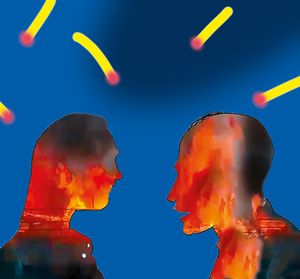Urban warfare is terrifying and destructive. American author Max Brooks said, “No conventional battlefield, no breakdown in social order can possibly prepare you for the nightmare that is a city besieged.” City combat is hardly new. Archaeological excavations show that Hamoukar in Syria was destroyed by urban warfare 5,500 years ago. History is littered with ruined cities. Yet, humankind never learns.
Gaza is the latest urban battlefield in recent times, following Mosul, Mogadishu, Kobani, Ramadi, Jaffna, Tigray, Khartoum, Darfur, Al-Fallujah, Raqqa and many more. Invasion of Gaza by Israeli Defense Force (IDF) to “destroy” Hamas for killing 1,400 Israeli civilians in the October 7 terror attack risks widening the conflict into a regional war in the Middle East, something that might ricochet around the world. This triggers unforeseen chain reactions in people already tense and fragile due to the cost of living and other crises.
In Brussels, two Swedes were killed by an illegal Tunisian migrant. In Chicago, a deranged landlord repeatedly stabbed to death his Palestinian tenant’s seven-year-old son. Anti-semitism and Islamophobia have risen with targeted revenge killing of white civilians and Muslims, especially in Germany and France. Palestinian activists “occupied” the EU office in Dublin, accusing the bloc of failing to condemn Israeli airstrikes that killed thousands of Palestinians.
Gaza is smaller than Iraq’s Mosul and the same size as Raqqa, which was the Syrian capital of the Islamic State. But with two million inhabitants, Gaza is more densely populated than most other recent urban warzones. There are similarities, but every urban battle-zone is unique, shaped by its topography, infrastructure, fighting forces and civilian networks. Hamas has tacit Iranian backing and commands greater local civilian support than did IS. It has more suicide bombers, drones, air defense and a warren of underground military tunnels that dramatically expands its battlespace capability. “This would entail a ground operation that is more than Mosul and Raqqa combined,” said Middle East military expert Michael Knights.
While IS had two years to fortify Mosul and Raqqa, Hamas has spent 30 years building subterranean, ground-level and above ground fortifications, creating communication channels, mining buildings, fighting positions and the routes of invading armoured vehicles. Said Brooks, “Urban combat is the most difficult. It lasts long because every building, every room, every subway tunnel, every car, every sewer pipe, every nook and cranny of this massive maze must be searched.”
The well-equipped IDF will bomb its way through. It knows every inch of Gaza, where it has fought two wars and conducted decades of continuous surveillance. Still, hiding guerrillas have an advantage over visible invaders… as US forces discovered in 1993 when Somali rebels shot down three American Black Hawk helicopters in Mogadishu, triggering bloody urban fighting. Said former CIA chief and US General David Petraeus, who served in Iraq and Afghanistan, “Gaza ground war could be Mogadishu on steroids. You’ll see suicide bombers, improvised explosive devices, there will be ambushes, booby traps. The urban setting could not be more challenging”.
Urban wars do not produce quick wins. They are easy for armies to get into, hard to get out of. Petraeus warned, "You don't win counterinsurgencies in a year or two. They typically take a decade or more." Inflamed expatriates and armchair warmongers typically goad their governments to escalate fighting—from the comfort of their cushioned seats in safe, faraway lands. But every war-ravaged civilian, every soldier, every trench journalist knows there are many ways to fight in an urban battleground. And even more ways to die.


